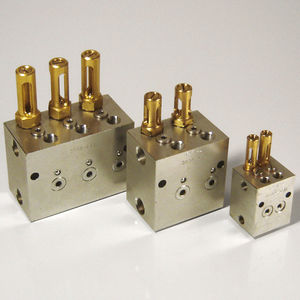
- Hydraulics - Pneumatics
- Valve
- Piston valve
- BIJUR DELIMON INTERNATIONAL
Piston valve 3000hydraulicsteelfor lubrication units



Add to favorites
Compare this product
Characteristics
- Type
- piston
- Operation
- hydraulic
- Body
- steel
- Applications
- for lubrication units
- Associated function
- unloading
- Other characteristics
- grease
- DN
0.375 in
- Pressure
Min.: 20 bar
(290.1 psi)Max.: 207 bar
(3,002.3 psi)
Description
The Series 3000 progressive divider valve manifold distributes and proportions incoming oil or
grease to bearing points. A typical divider valve manifold consists of an inlet section, three to ten
valves and an end section. One assembly can serve up to a maximum of 20 lubrication points. Location
of valve blocks within the manifold is not critical – however, it is recommended that the largest block
be located next to the inlet block.
Individual divider valve blocks have a sliding discharge piston and built-in outlet check valves. Blocks
are offered in six output sizes. The discharge capacity of a block is determined by varying the piston
diameter in the valve block. Valve blocks have two outlets located at each end of the assembly (double
outlet blocks) and supply rated discharge outputs from each of the two outlets during one complete
valve cycle.
Single outlet blocks have one end outlet plugged (right side, inlet at top) and supply twice the rated
output to the open outlet (left side, inlet at top). For a right sided open outlet, simply remove plug and
insert in the left outlet. External cross porting of adjacent valves can be achieved with a kit to
combine outputs.
Operation
Individual valve blocks operate in a pre-arranged “progressive” sequence. During operation, the
piston within the block must complete a full discharge cycle before another piston begins operation.
As long as lubricant is supplied under pressure to the inlet section of the divider, manifold valve
blocks will continue to operate in a progressive manner.
When lubricant flow is interrupted to the inlet block, piston movement stops.
Catalogs
Other BIJUR DELIMON INTERNATIONAL products
DISTRIBUTION ELEMENTS
*Prices are pre-tax. They exclude delivery charges and customs duties and do not include additional charges for installation or activation options. Prices are indicative only and may vary by country, with changes to the cost of raw materials and exchange rates.


















